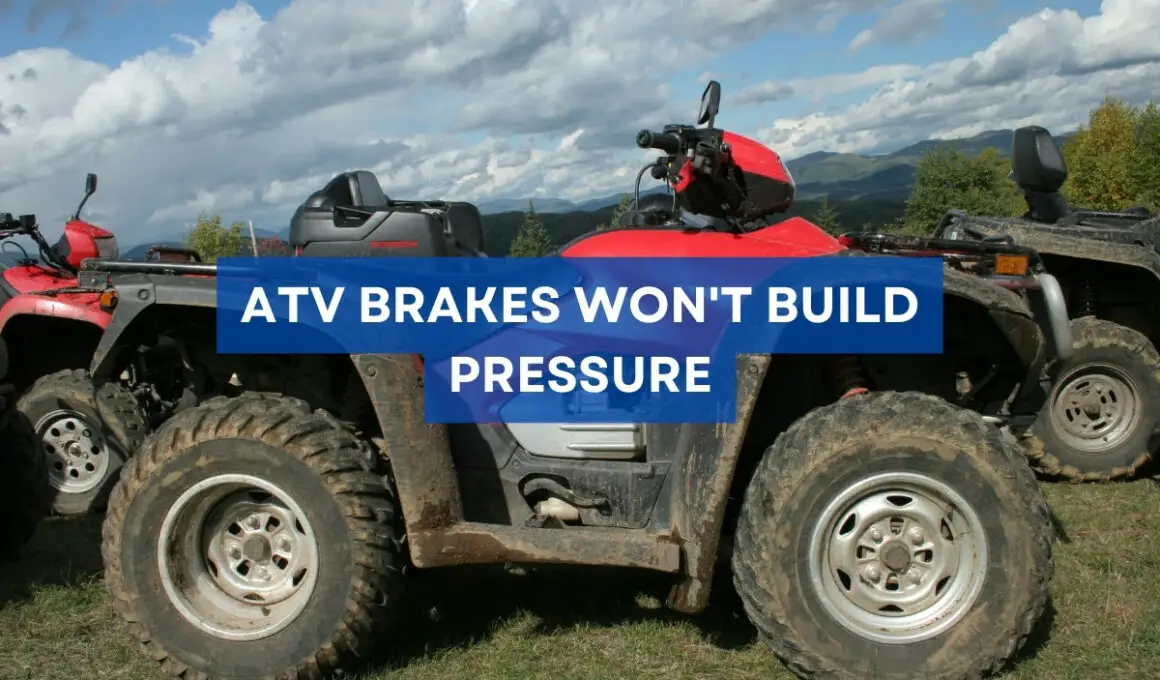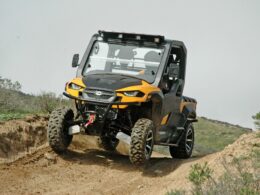In This Article Show
Key Takeaways
- ATVs use a hydraulic system for effective stopping power.
- Common issues include air in lines, worn pads, fluid leaks, and cylinder problems.
- Regular checks, quality brake fluid, and timely repairs ensure optimal brake function.
Off-roading is an exhilarating experience close to my heart for years. Whether you’re barreling down a trail on a dirt bike, exploring challenging terrains on an ATV, or taking the family out for a weekend adventure on a UTV, a sense of freedom comes with it.
However, that freedom goes hand in hand with responsibility — a primary one being ensuring your equipment is in top-notch condition.
Now, when it comes to ATVs, a common hiccup I’ve encountered in my rides and the numerous folks I’ve guided over the years revolves around the brake system, specifically when they fail to build pressure.
It’s not just a mild inconvenience; it’s a potential hazard. But, not to fret. Through my experience, I’ve learned to identify the causes and know the fixes. In this post, we’ll dive deep into why your ATV brakes might give you grief by not building pressure and, most importantly, how to fix it.
Understanding Brake Pressure
Navigating the diverse terrains that off-roading presents is no small feat. Every bump, decline, and sharp turn demands precise control. A significant part of this control hinges on your braking system. Before diving into the problems, we must grasp how brake pressure works, especially in an ATV.

How Brake Systems Work in ATVs
ATVs, like most vehicles, primarily utilize a hydraulic brake system. When you press the brake lever or pedal, you apply force to a master cylinder filled with brake fluid. This action forces the brake fluid through a series of tubes and hoses, activating the brake calipers to clamp down on the brake rotors.
This clamping motion is what brings your ATV to a halt. The effectiveness and speed of this stopping motion depend on the pressure within the brake lines.
Importance of Maintaining Good Brake Pressure
Brake pressure is the force exerted by the brake fluid when you apply the brakes. Think of it as the messenger between your foot or hand and the brakes.
If this messenger is sluggish or absent, the message doesn’t get through effectively. In simpler terms, your ATV won’t stop promptly without adequate brake pressure, posing risks, especially when off-roading.
Over my years on the trail, I’ve realized that understanding your machine is half the battle. When you know what’s happening beneath you, diagnosing and preventing problems becomes much easier. And trust me, the last place you want a brake problem is miles from the nearest road.
Common Causes for Loss of Brake Pressure in ATVs
Brakes not responding as they should can be unsettling, to say the least. It’s vital to diagnose the problem promptly to ensure your safety. Here are the most common culprits that could be causing your ATV brakes to lose pressure:
1. Air In The Brake Lines
Air is compressible, unlike incompressible brake fluid. Air entering your brake system creates soft spots or sponginess in your brake lever or pedal. This means even if you press down hard, the pressure isn’t effectively transferred to the brake calipers, leading to a lack of stopping power.
Symptoms of air in the brake lines are spongy or soft brake lever or pedal, decreased brake efficiency, and the need to pump the brakes multiple times to achieve the desired stopping power.
2. Worn or Damaged Brake Pads
As brake pads wear down over time, the distance they need to travel to contact the rotor increases. This can create a feeling of decreased brake pressure. Furthermore, if they’re unevenly worn or damaged, they might not make full contact, further reducing effectiveness.
Signs of worn-out brake pads are;
- Squealing or grinding noises when braking.
- Vibration in the brake pedal or lever.
- Reduced stopping power.
3. Leaking Brake Fluid
Brake fluid is the lifeblood of your hydraulic brake system. If there’s a leak anywhere, from the master cylinder to the calipers or along any of the brake lines, you’ll experience a drop in brake pressure. This is because there’s less fluid to exert that necessary force.
Signs of a brake fluid leak;
- Wet spots or puddles beneath your ATV.
- Brake fluid levels drop in the reservoir.
- Soft or spongy brake feel.
4. Damaged or Clogged Brake Lines
Brake lines are the highways for your brake fluid. Any damage, like pinches cracks, or obstructions can impede the fluid’s flow, causing a decrease in brake pressure. Symptoms to look out for:
- Visual damage to the brake lines.
- Soft brake feels even after bleeding.
- Unexplained loss of brake efficiency.
5. Master Cylinder Issues
The master cylinder is the starting point of the hydraulic process. If it fails or malfunctions, the entire brake system is compromised. Internal seals can wear out or the cylinder itself can get damaged. Common issues and symptoms;
- Slow brake fluid leak from the rear of the master cylinder.
- Spongy brake feel that doesn’t resolve after bleeding.
- Brake fluid contamination or discoloration.
Identifying the root of the problem is the first step to restoring your ATV’s brake efficiency. With this understanding, we can delve into the solutions tailored to each issue.

Fixes for Regaining Brake Pressure
Once you’ve diagnosed the root cause of your brake pressure problem, the next step is to address it. Here’s a rundown of solutions tailored to each common issue;
1. Bleeding the Brakes
When air gets trapped in your brake system, bleeding is expelling and restoring brake efficiency. Here is the step-by-step guide;
- Secure the ATV on level ground.
- Locate the brake fluid reservoir and open it.
- Connect a clear hose to the bleeder valve on the brake caliper, placing the other end into a container.
- Pump the brake lever or pedal a few times and hold it down.
- While holding the lever or pedal, open the bleeder valve to release the trapped air and some fluid. Close the valve promptly.
- Repeat the process until no more air bubbles appear in the fluid being expelled.
- Top up the brake fluid reservoir as needed and ensure the lid is secured after.
2. Replacing Brake Pads
Worn-out brake pads can diminish stopping power. It’s essential to replace them for safety and optimal brake performance. How to change the brake pads:
- Elevate the ATV, ensuring it’s stable.
- Remove the wheel exposing the brake caliper.
- Detach the caliper and slide out the old brake pads.
- Insert the new brake pads and reattach the caliper.
- Repeat on the other side if necessary, and reinstall the wheels.
3. Fixing Brake Fluid Leaks
A consistent brake fluid level is vital for maintaining pressure. You can identify the source by visually inspecting all brake lines, connections, and the master cylinder. Look for wet spots, drips, or damaged areas.
Minor leaks at connections might be resolved by tightening or replacing the connector.
Significant leaks or damage to the master cylinder often require professional attention.
4. Cleaning or Replacing Brake Lines
Ensure the pathways for your brake fluid are clear and in good shape. You should disconnect brake lines and use a brake cleaner fluid. Also, allow them to dry thoroughly before reconnection.
Visible damage, like cracks or pinches, and persistent brake problems even after other fixes are the clear signs that you should replace the brake lines.
5. Master Cylinder Replacement
When the master cylinder is compromised, it might be time for a replacement. The following are steps to replace the master cylinder;
- Disconnect the brake lines attached to the master cylinder.
- Remove the master cylinder from its mounting.
- Install the new master cylinder, ensuring all connections are secure.
- Bleed the brakes to ensure no air entered the system during replacement.
Addressing these issues promptly ensures that your ATV remains safe for all your off-roading adventures. Regular maintenance and checks will help you catch problems early, preventing bigger issues.
Preventative Maintenance to Avoid Brake Pressure Issues
Proactive care of your ATV’s brake system ensures smooth rides and significantly reduces the likelihood of unforeseen issues cropping up. Here are some preventive measures to maintain optimal brake pressure:
1. Regular Inspection Routine
At least once before every major off-road trip or every month for frequent riders. Check the brake fluid levels, inspect brake pads for wear, and scan the brake lines for any visible damage or leaks.
2. Use Quality Brake Fluid
High-quality brake fluid resists contamination and degradation, ensuring efficient brake performance. Always use the type of brake fluid recommended in your ATV’s manual.
3. Address Issues Immediately
If you notice any anomaly, like a soft brake feel or unusual noises, address it immediately. Postponing repairs can escalate minor issues into major ones, leading to costlier fixes or potential safety hazards.
4. Avoid Overloading the ATV
Excess weight puts additional strain on the brakes, leading to premature wear. Always adhere to your ATV’s weight limits and balance the load evenly.
5. Store in Suitable Conditions
When not in use, store your ATV in a dry, cool place, away from direct sunlight. Prolonged exposure to harsh elements can degrade brake lines and other components.
6. Bleed Brakes Periodically
Even if you don’t notice any issues, it’s a good practice to bleed your brakes occasionally to ensure there’s no trapped air and that the brake fluid remains uncontaminated.
7. Replace Old Brake Fluid
Brake fluid can absorb moisture over time, which reduces its effectiveness. It’s wise to completely replace the brake fluid every 1-2 years or as recommended in your ATV’s manual.
In Conclusion
Familiarize yourself with your ATV’s specific brake system model. Every model might have its unique requirements, and being informed helps catch potential issues early.
A combination of regular checks and proactive care will ensure that your ATV’s brakes remain in top shape, giving you peace of mind during every ride.










